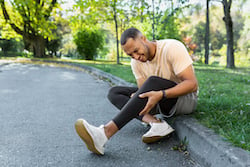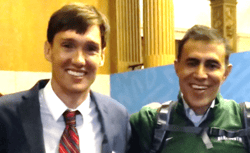 While common among runners, bone stress injuries (BSI) take a heavy psychological toll on athletes, primarily because it means they'll be sidelined for an extended period. Because BSIs are notoriously difficult to heal, runners face the prospect of a prolonged time away from the sport, making it a devastating diagnosis. With a busy marathon season ahead, the retrospective study “Outcomes Using Focused Shockwave for Treatment of Bone Injury in Runners” was published in Bioengineering and is particularly well-timed. The objective of the study by Alexander Beling, MD, Amol Saxena, DPM, Karsten Hollander, MD, and Adam S.Tenforde, MD, is to detail the use and effectiveness of Extracorporeal Shockwave Therapy (ESWT) in the management of BSI in runners.
While common among runners, bone stress injuries (BSI) take a heavy psychological toll on athletes, primarily because it means they'll be sidelined for an extended period. Because BSIs are notoriously difficult to heal, runners face the prospect of a prolonged time away from the sport, making it a devastating diagnosis. With a busy marathon season ahead, the retrospective study “Outcomes Using Focused Shockwave for Treatment of Bone Injury in Runners” was published in Bioengineering and is particularly well-timed. The objective of the study by Alexander Beling, MD, Amol Saxena, DPM, Karsten Hollander, MD, and Adam S.Tenforde, MD, is to detail the use and effectiveness of Extracorporeal Shockwave Therapy (ESWT) in the management of BSI in runners.
Bone Stress Injury: Diagnosis and Treatment
BSI is triggered by overuse and excess loading on the bone, and the resulting injury ranges from stress reactions to stress fractures. Clinical history, physical examination findings, imaging, and MRI confirm the diagnosis. The severity of the damage is usually graded on a scale from 1 – 4, with 4 being the most advanced injury–stress fracture. Along with grading, many other factors can influence the healing rate and timeline to return to sport.
The traditional approach to BSI is conservative and non-surgical and frequently includes the following:
- Off-loading the bone
- Physical therapy, in all cases
- Gradual progression when returning to sport or training
- Activities are reintroduced and advanced (in the absence of pain)
- The use of bone stimulators is considered
In this case series, focused Extracorporeal Shockwave Therapy (ESWT) holds great promise as a favorable method for managing BSI in runners. Since its initial use in urology to treat kidney stones, known as lithotripsy, shockwave has been recognized as a game-changing treatment for musculoskeletal disorders, and its accepted uses are expanding regularly.
Materials and Methods
For the retrospective case series, a chart review was conducted to ascertain the eligible patients seen in one physician’s clinic between August 2018 to September 2022. Here’s a breakdown of eligible patients:
- 40 runners, with 41 injuries and radiographic confirmed BSI
- 28 females, 12 men
- Running as the primary sport
- 26 patients met the criteria for moderate to high-risk Female or Male Athlete Triad categories
- All patients adhered to activity restrictions and follow-up
- Patients started ESWT at a median of 36 days from the bone stress injury
Case Series Protocol for Bone Stress Injury
All patients underwent thorough evaluation, physical exam, and imaging review before undergoing Extracorporeal Shockwave Therapy ESWT treatment. Additionally, each patient was screened for Triad risk factors, including:
- Low bone mineral density
- History of prior BSI
- Other fractures
- Prior eating disorder
- Menstrual history
- Low testosterone
Also, each runner was instructed on the importance of calcium and vitamin D intake. Sports medicine provider Adam S. Tenforde, MD, developed the ESWT treatment protocols. Here is an overview of the protocol:
- Minimum of 3 ESWT treatment sessions at the site of BSI
- ESWT performed using bony landmarks and clinical focusing techniques
- Additional radial shockwave for myofascial pain if needed
- Clinical follow-up 6-8 weeks later
- At physical assessment ( including single and double-leg hop), palpation and percussion of the affected bone are performed
- Repeat imaging
- Patients with residual pain received additional ESWT treatments
- Walk/run land progression, using alternating intervals of activity
- Anti-gravity treadmill
- Additional ESWT to stimulate bone consolidation For those with no pain, return to run was prescribed
- Every patient received physical therapy
Clinical Outcomes and Conclusions on ESWT for Bone Stress Injury
This case series demonstrated remarkable outcomes, with 98% having a triumphant and pain-free return to sport. Those with high-grade BSI (3 and 4) experienced longer return-to-run timelines than those with lower-level, grade 1 and 2 injuries.
It’s evident in the retrospective study that treating BSI with moderate to high energy-focused ESWT is safe and efficacious.
This present study features the advantages of a larger sample size than previously presented in other published studies.
Two Study Authors in the News
In related news, an article in the New York Times, “The Real Power of Super Sneakers Could Be Super Recharged Training,” by Amby Burfoot, mentioned renowned experts in the study of running injuries, Amol Saxena, DPM, and Adam S. Tenforde, MD.
An excerpt from the article:
“Two experts in the study of running injuries, Adam Tenforde and Amol Saxena, believe that wearing supershoes can lead to serious ailments.
In February, they co-authored a paper in the journal Sports Medicine that presented five case studies of navicular bone injuries stemming from the use of supershoes.
‘I've seen supershoe injuries in runners of all levels: high school runners, recreational runners and elite athletes,’ says Saxena. ‘Sneakers can exert atypical stresses on bones and soft tissue structures.'
As one might expect, neither is a proponent of super shoes and believes their usage can lead to serious injury."
(Please note a subscription to The New York Times is required to read this article in its entirety.) Amol Saxena, DPM, MPH, and Adam S. Tenforde, MD, are renowned experts in running-related injuries. The New York Times article points to a study they published earlier this year in the Journal of Sports Medicine, “Bone Stress Injuries in Runners Using Carbon Fiber Plate Footwear,” which explores navicular bone injuries caused by the use of super-shoes.
Amol Saxena, DPM, MPH, and Adam S. Tenforde, MD, are renowned experts in running-related injuries. The New York Times article points to a study they published earlier this year in the Journal of Sports Medicine, “Bone Stress Injuries in Runners Using Carbon Fiber Plate Footwear,” which explores navicular bone injuries caused by the use of super-shoes.
And, take note, Adam Tenforde, MD, and Amol Saxena, DPM, MPH, will present at the upcoming American Society of Podiatric Sports Medicine (AAPSM) Conference in October 2023.
Ready to Accelerate Healing and Practice Growth?
Are you interested in delving deeper into the effects of ESWT, EPAT, EMTT, and other regenerative remedies by CuraMedix?
Our specialists are poised to respond to your queries and provide customized advice. Embark on a journey to discover how these groundbreaking technologies can revolutionize your medical approach and achieve optimal patient results. Contact us today to gain insights into the benefits and possibilities presented by these regenerative advancements.



